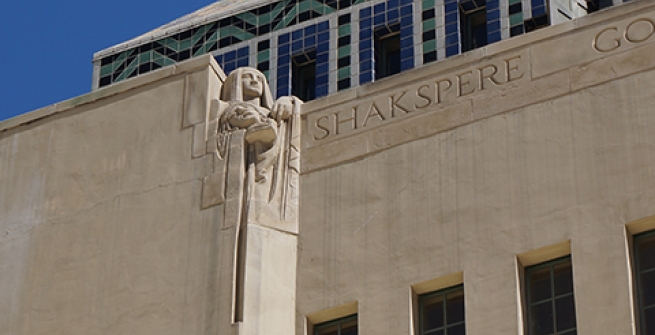Have you ever climbed the old marble staircase in our Central Library and, glancing up, spied a lit window cozily lined with books and plants? Or attended a Saturday puppet show in the Children's Department and noticed, high on the north wall, geometrically patterned perforations that open into an enticing space beyond? In both cases you are seeing the kind of unexpected, slightly mysterious pockets of space that are no longer part of large scale building design.
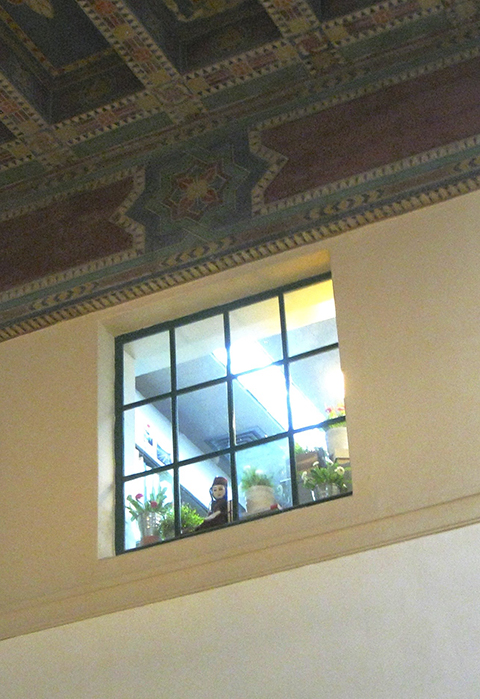
Window above North Staircase
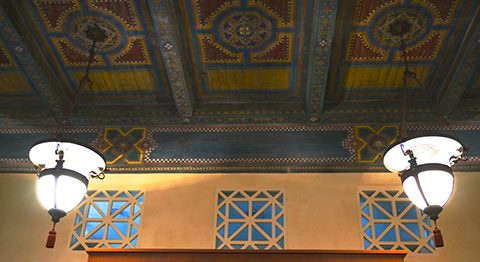
Window overlooking Puppet Theatre
Old buildings fascinate us with the possibility that they contain “secret” rooms. Of course, such spaces were not secrets to the original builders. But as time passes and functions change, parts of buildings fall into disuse and can become forgotten. Or old, once commonplace structural components can seem picturesque and quirky to modern eyes accustomed to the boring repetition of newer grid system construction. The 1926 portion of our Central Library, now named the Goodhue Building after architect Bertram Goodhue, has a variety of such areas. This article introduces you to a variety of spaces that for reasons of safety and security are closed to the public, but are nevertheless fascinating to learn about. Please respect these necessary rules.
Mezzanine
The two spaces cited above are part of the Goodhue Building’s mezzanine level. A mezzanine, (from the Italian “mezzanino” meaning intermediate) is generally a partial floor between the main level of a building and offices or hotel rooms above. In older buildings it can be a kind of balcony with an elevator stop that gives access to office corridors in buildings where the lobby level is devoted to retail. (The 1921 Pacific Mutual Building across Grand from the Tom Bradley Wing has a particularly fine example).
The most interesting variant of a mezzanine is what we find in the Goodhue Building. Important public buildings such as our library were (so to speak) built to impress. They often featured grand public spaces with dramatically high ceilings, the rotunda being a good example. Surrounding such spaces would be corridors, offices, etc. with lower ceilings. The inflexibility of load bearing masonry walls meant that height disparity between such rooms resulted in pockets of “wasted” space. But more or less connected up, (sometimes by ramps because of varying floor levels), these spaces could constitute a usable partial level between floors. (Modern steel girder construction has eliminated such spaces.)
Mezzanines have an air of mystery because they were treated as quasi-invisible spaces. Today the Goodhue Building is divided into four floors (plus two basement levels.) But if you examine original building plans there appear to be only three stories: the lower level, the main rotunda level and a top floor with offices, library board room and so on. What today is labeled the third floor was then identified as a mezzanine. Or more to the point, not identified at all. Not part of a published floor plan and with inaccessible backstairs entry points, you might only have known of its existence from staff members or via a mention in the 1927 guidebook: “Above the main reading rooms are mezzanines divided into study, club, committee and conference rooms…”
Today those parts of the Goodhue Building’s mezzanine still in use are mostly the province of Special Collections. The lit window one can see above the North Staircase is an office belonging to Ani Boyardjian, Principal Librarian in charge of Special Collections. Other than the glare from looking down on one of the elegant lighting fixtures, Ani enjoys the view and says people often spot her and wave to her from the stairs.
On the wall opposite Ani’s office, another window reveals steel shelves with books and archival boxes. It offers a peek into secure storage areas housed in an extensive complex of low ceilinged narrow rooms where some of the wonderful rarities owned by the library are stored. From my calculations these rooms occupy pockets of space winding between and around the rotunda and the old reading rooms throughout the northwest quadrant of the Goodhue Building. Walking through this warren of rooms can be confusing. Whatever access to daylight they once enjoyed has been blocked off to protect light sensitive paper materials.
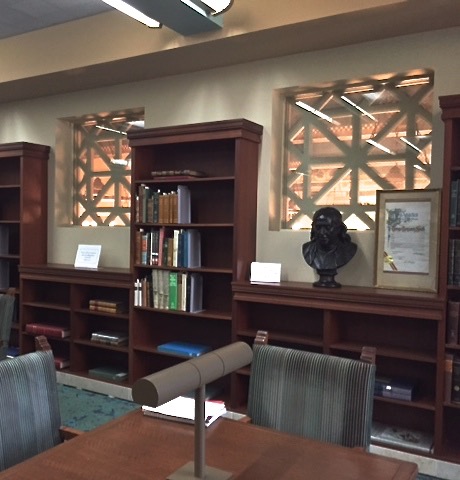
Windows in Rare Books Room overlook the Getty Gallery
There is one spot where one can see from Special Collections into other spaces. It is the Rare Book Room, whose ceiling light fixtures one sees through the north wall above the puppet theatre. Rare Books sits over a low corridor separating what were originally two main reading rooms—Sociology and Science and Industry—which today are respectively the Storybook Room of the Children’s Department and the Getty Gallery. It’s an impressive room lined with bookcases, at one end giving onto a balcony concealed behind the on the Flower Street facade. Part of its charm is the geometrically patterned perforated “windows” that look through to the old reading rooms below. On one side they provide a lovely close-up view of the painted ceiling in the Storybook Room. Unfortunately on the Getty Gallery side the immediately visible ceiling was so damaged in the devastating 1986 arson fire it has been covered with sheetrock. Other remains of mezzanine spaces stretching around the building’s south side are variously used as workrooms and storage.
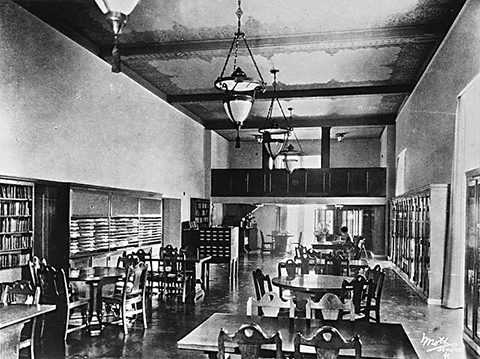
Art Room with Balcony 1926
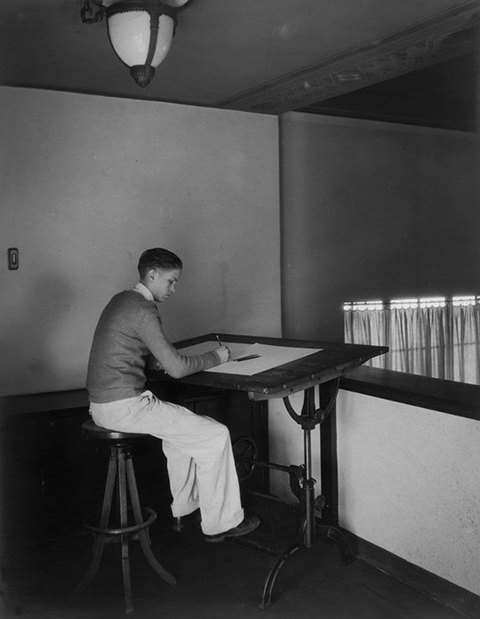
Drafting Tables on Balcony above Art Room
Changing Functions, "Lost" Spaces and Pockets of Charm
Besides the mezzanine, other intriguing pockets of space serve to remind us of how the library has adapted to changing functions over the decades. Most library patrons are familiar with the former Children's Reading Room that, because of its beautiful murals, was preserved within the new Bradley Wing. But do you know the corresponding space directly above, also saved from demolition, was the former Art Room? It was constructed with a balcony at one end furnished with drafting tables to allow artists to work from illustrations in books. Now part of the Art, Music and Recreation Department, it is closed and used for storage. But if (with permission of a staff member) you climb the narrow staircase, you’ll find a lovely windowed space.
From original plans and old descriptions, one realizes that tucked away in architect Bertram Goodhue’s design for the library are spaces that were built but for some reason never used as intended. The architect wanted to take advantage of California’s temperate climate and utilize outdoor rooms as part of his library building. On the original plans for the third (top) floor, he included what is labeled a promenade that was accessible from the head librarian’s office, the library commission boardroom, etc. (Those offices are now occupied by Human Resources.) An old photo shows the space, located behind the Hope Street facade’s parapet, under construction. Today the original French doors open onto a graceful tile-floored terrace that for whatever reason is never used. A few container plants could turn it into the outdoor space for staff envisioned by Goodhue.
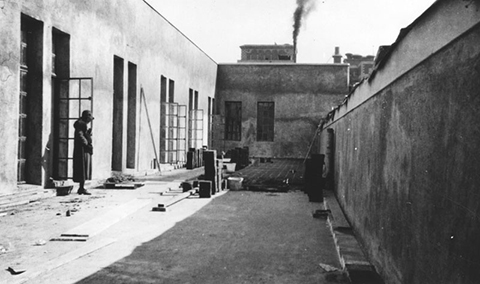
Promenade facing Hope Street under construction 1926
Speaking of spaces no longer used, among the truly mysterious is a walkway surrounding the tower directly under the pyramid. The 1927 guidebook speaks of visitors taken up for “a bird’s eye view of the surrounding city”. One can spot original bronze doors that open onto the walkway, but how did people ever get up to that level? From inside the tower, the only access visible is via high metal ladders attached to sheer concrete walls. It would take a rope climber to ascend that way. Did a staircase once exist?

Parapet Walkway below Pyramid
Finally, not a hidden space, but a personal favorite of mine: Among the many lovely elements of Goodhue’s original design are the multi-paned metal-framed windows, painted (as per his instructions) a deep blue green. In a couple of places those windows are low enough to function as French doors giving onto small metal balconies. You can find them in the small rooms that sit at either end of the Children’s Department. Originally the California and Map Rooms, they are now the Children's Computer Center and the Family Reading Room. From the reading room the window frames a view of Robert Farquhar’s 1929 California Club. Or take a look in the Children's Computer Center. A comfortable chair is placed next to such a window that looks out over the balcony onto the Hope Street terraces. One can imagine sitting with a cup of tea (Downton Abbey anyone?) contemplating the library garden.

Old casement windows in Children's Reading Room
Intrigued? An LAPL docent would be happy to point out these hidden spaces. Join us for a tour of both the 1926 Bertram Goodhue-designed building and the Norman Pfeiffer-designed addition, completed in 1993. Tours are Monday through Friday at 12:30 p.m., Saturdays at 11 a.m. and 2 p.m., Sundays at 2 p.m. All tours are free. Scheduled tours can be arranged by writing jung@lapl.org
Article by Kenon Breazeale
All photos courtesy of the LAPL Collection and Mary Valentine
